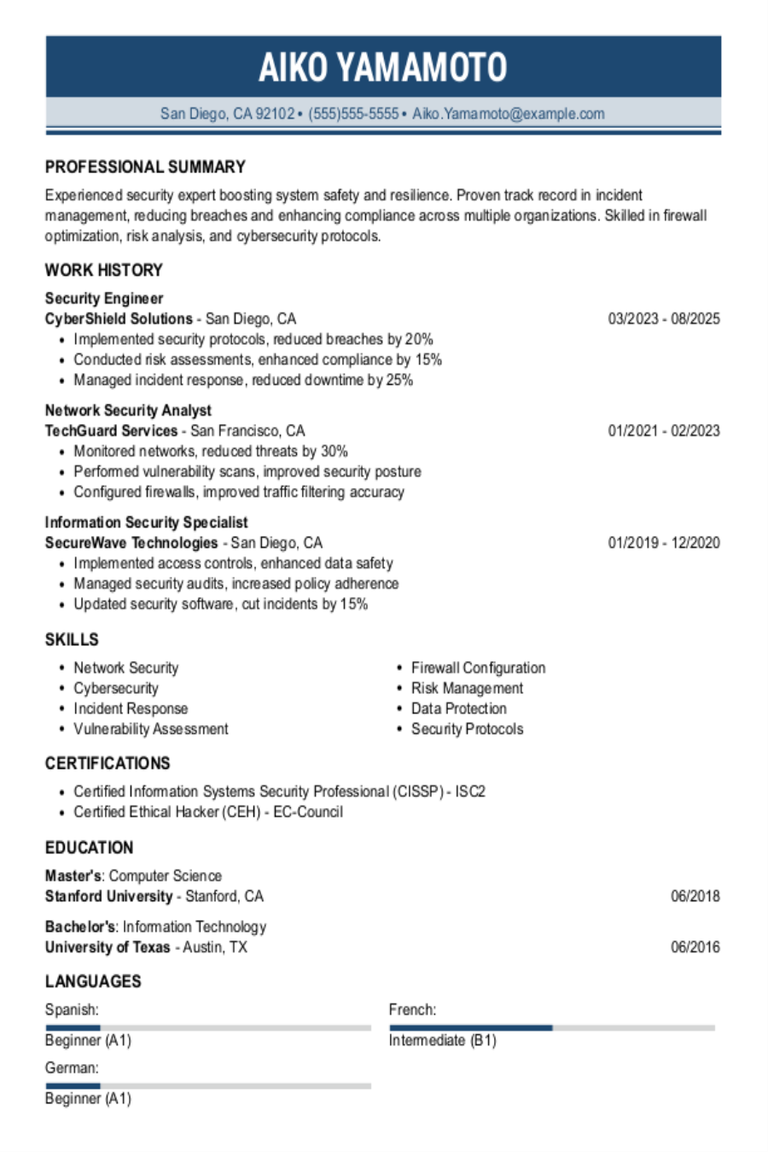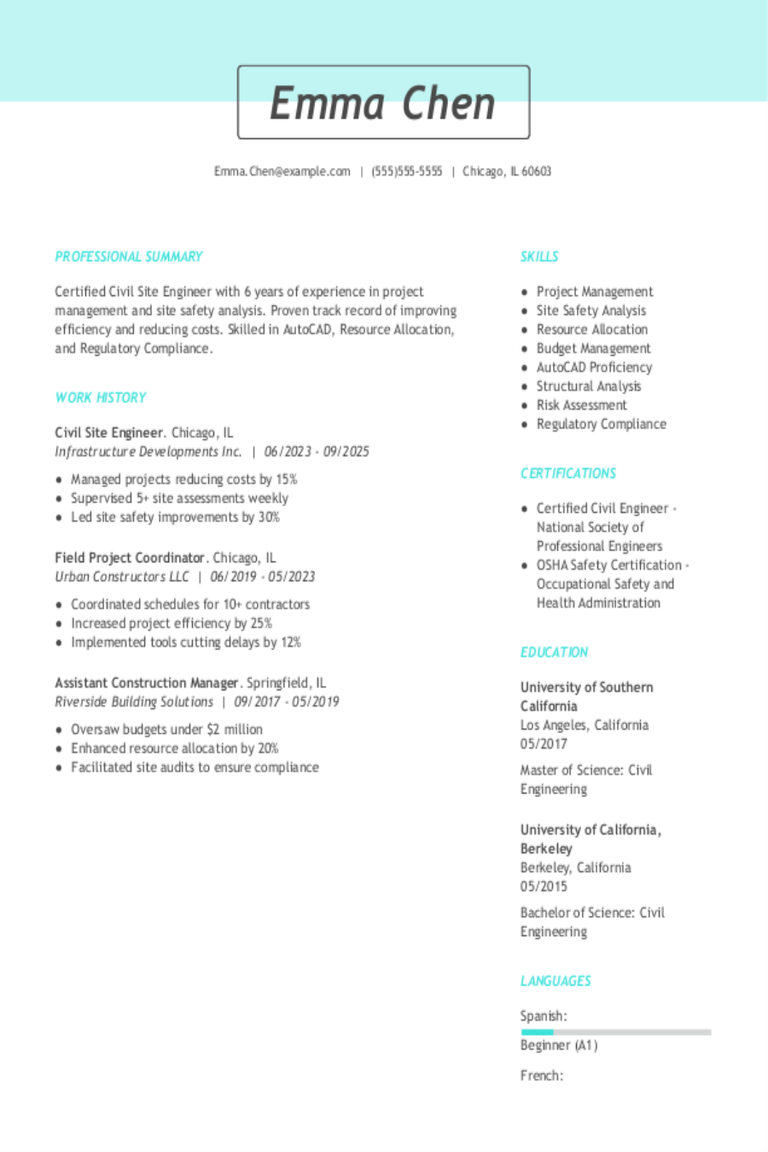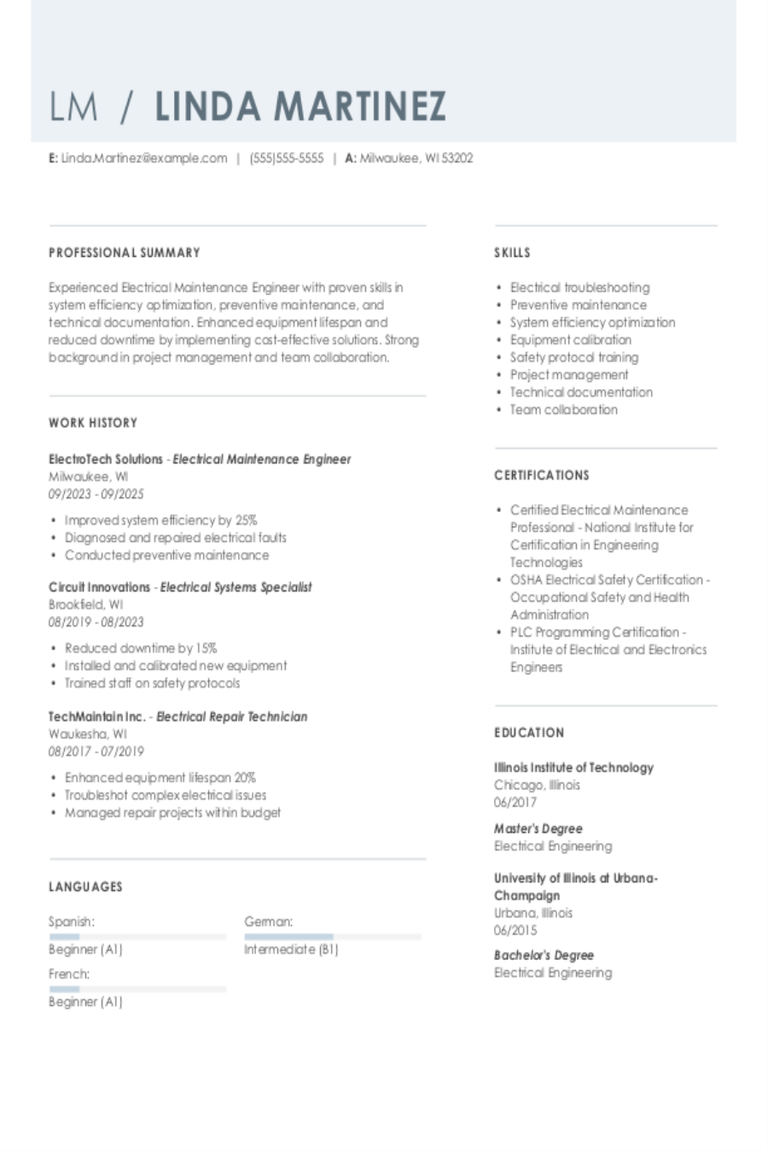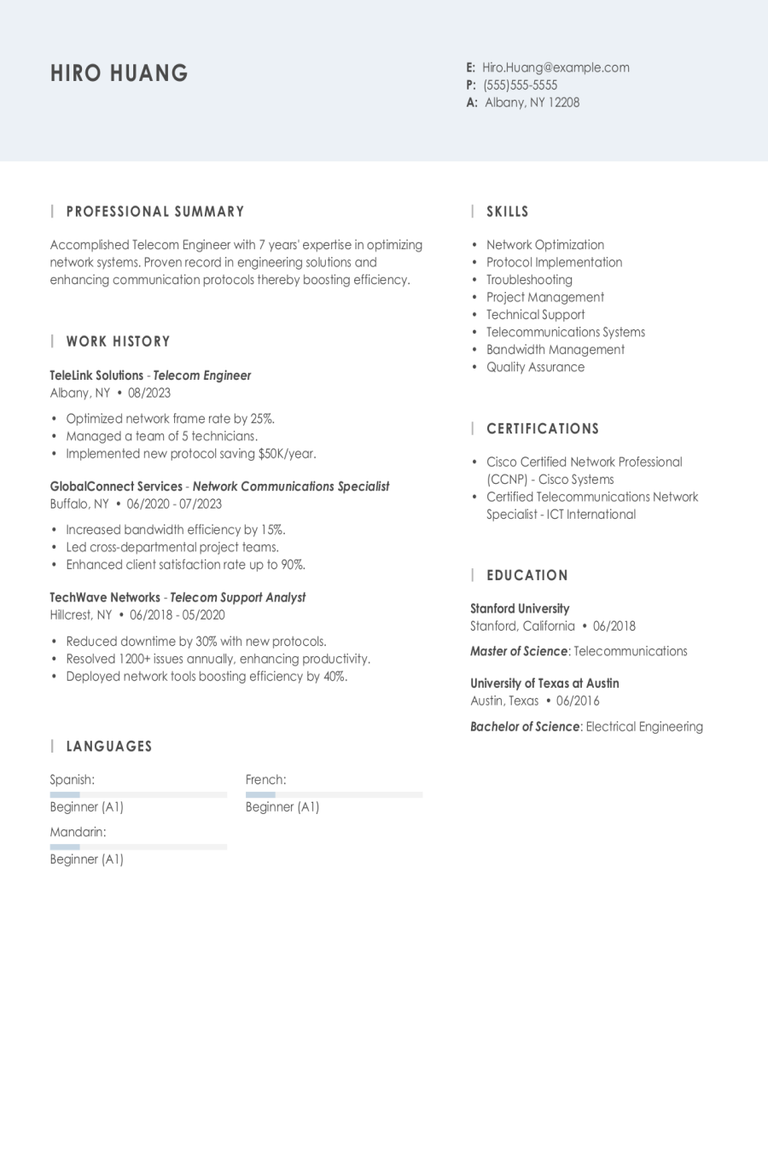Why this resume works
- Quantifies accomplishments: By showcasing measurable accomplishments like improving system uptime by 20% and reducing costs by $50k annually, the applicant emphasizes their significant impact and value.
- Showcases career progression: Moving from reliability technician to engineer roles shows the applicant’s career growth, highlighting a journey of increasing responsibility and expertise in the field.
- Uses action-oriented language: Using powerful action verbs such as “improved,” “implemented,” and “led” conveys a proactive approach in driving results.
More Reliability Engineer Resume Examples
Our reliability engineer resume examples show how to feature your problem-solving skills, attention to detail, and experience with maintenance planning. Use these electrical engineering resume samples to create a compelling resume that showcases your expertise in ensuring system dependability.
Entry-Level Reliability Engineer
Why this resume works
- Centers on academic background: Focusing on degrees from Stanford and UC Berkeley, the applicant’s education section emphasizes academic excellence early in their engineering career.
- Puts skills at the forefront: By prioritizing key skills like predictive maintenance and asset management, the applicant uses a skills-based resume format to effectively showcase their capabilities.
- Effective use of keywords: Using industry-specific keywords, such as root cause analysis and lean manufacturing, boosts visibility in applicant tracking systems (ATS).
Mid-Level Reliability Engineer
Why this resume works
- Points to measurable outcomes: Emphasizing quantifiable improvements like reducing equipment failure by 15% showcases the applicant’s impact through measurable outcomes.
- Displays technical expertise: Certifications such as Six Sigma Green Belt and expertise in reliability analysis highlight the applicant’s strong technical foundation.
- Demonstrates language abilities: Listing language skills in Spanish, French, and German indicates readiness for international collaboration.
Experienced Reliability Engineer
Why this resume works
- Showcases impressive accomplishments: The applicant’s accomplishments reveal a knack for impactful results, like reducing maintenance costs by 25% and saving $100K through process optimizations.
- Focuses on work history: Using a chronological resume format, the applicant effectively maps out their journey from systems technician to reliability engineer, showcasing career growth over time.
- Emphasizes leadership skills: The applicant managed a team of six and led projects that decreased downtime by 15%, demonstrating leadership skills and initiative.
Reliability Engineer Resume Template (Text Version)
Ming Chen
Portland, OR 97210
(555)555-5555
Ming.Chen@example.com
Professional Summary
Dynamic reliability engineer with 9 years’ expertise in predictive maintenance, system optimization, and team leadership. Proven record of enhancing equipment reliability and efficiency in high-stakes environments.
Work History
Reliability Engineer
TechSolutions Inc. – Portland, OR
January 2022 – July 2025
- Enhanced system uptime by 20% through root-cause analysis
- Implemented predictive maintenance reducing costs by k annually
- Led cross-functional team to improve equipment reliability
Maintenance Engineer
Innovative Machines Co. – Portland, OR
January 2017 – December 2021
- Increased machine efficiency by 15% using advanced diagnostics
- Developed maintenance plans cutting downtime costs by 30%
- Trained staff on new maintenance procedures boosting safety
Reliability Technician
MachineryWorks Ltd. – Portland, OR
January 2015 – December 2016
- Prevented equipment failures through regular inspections
- Optimized schedules increasing operational efficiency by 25%
- Documented maintenance activities for compliance audits
Skills
- Predictive Maintenance
- Root-Cause Analysis
- Reliability Testing
- Failure Mode Effects Analysis
- Mechanical Systems Design
- Data Analysis
- Project Management
- Team Leadership
Education
Master of Science Mechanical Engineering
University of California, Berkeley Berkeley, California
June 2014
Bachelor of Science Mechanical Engineering
Michigan State University East Lansing, Michigan
June 2012
Certifications
- Certified Reliability Engineer – American Society for Quality
- Six Sigma Black Belt – International Quality Federation
Languages
- Spanish – Beginner (A1)
- German – Beginner (A1)
- French – Intermediate (B1)
Related Resume Guides
Advice for Writing Your Reliability Engineer Resume
Explore our advice on how to write a resume for a reliability engineer position. Learn how to highlight your problem-solving skills, experience with predictive maintenance, and passion for ensuring system stability.
Highlight relevant technical skills
For a reliability engineer, technical skills are key to ensuring systems and products work as expected over time. When writing your resume, it’s helpful to include a skills section that lists specific abilities related to the job. This helps employers quickly see what you can do. You can also weave these skills into your work experience section, showing how you’ve used them in real-world situations.
Strong technical skills are essential for reliability engineers, as they directly support the ability to improve system performance and reduce downtime. Core competencies often include predictive maintenance techniques, statistical analysis, data interpretation, and quality assurance methodologies.
Proficiency in root cause analysis and Failure Mode and Effects Analysis (FMEA) is also key, along with experience using tools like MATLAB, R, or other data-focused engineering software.
When adding technical skills to your resume, tailor them to match the job description. Focus on the qualifications most relevant to the position to make it easy for employers to recognize your fit. Aligning your skill set with their needs highlights your ability to contribute effectively and reinforces your value as a reliability engineer.
Example of a technical skills section
- Reliability analysis & testing
- Failure mode and effects analysis (FMEA)
- Root cause analysis (RCA)
- Predictive maintenance techniques
- Condition monitoring tools
- Asset management software (IBM Maximo, SAP PM)
- Vibration analysis
- Statistical process control (SPC)
- Maintenance planning & scheduling
- Risk assessment methodologies
You can use our Resume Builder to craft a resume that highlights technical skills in addition to key soft skills like teamwork, communication, and leadership.
Quantify your accomplishments
Quantifying your accomplishments makes your resume more persuasive by showing the real impact of your work, not just your responsibilities. For a reliability engineer role, go beyond general tasks like “maintained equipment” and turn them into specific achievements. For example, “reduced equipment downtime by 20% through proactive maintenance strategies” clearly communicates your value and effectiveness.
In your work experience section, include your job title, employer name, location, and dates of employment to provide essential context. Then, use strong action verbs paired with measurable outcomes to describe each role.
Rather than saying “improved processes,” say “boosted process efficiency by 30% by implementing lean methodologies.” This results-oriented approach gives hiring managers immediate insight into your capabilities.
By quantifying your contributions, you make it easier for employers to see how you’ve driven performance and solved problems in previous roles. It’s not just about showcasing numbers—it’s about telling a clear, credible story of your impact as a reliability engineer.
5 reliability engineer work history bullet points
- Implemented predictive analytics in maintenance processes, reducing equipment failure rates by 25%.
- Conducted root cause analysis on critical systems, decreasing recurring issues by 30%.
- Collaborated with cross-functional teams to develop reliability testing protocols, improving product lifespan by 15%.
- Led a project to upgrade monitoring tools, achieving a 20% increase in system reliability.
- Streamlined asset management strategies, resulting in an annual cost savings of $50,000.
Need help starting your resume? Check out our professional resume examples to get inspired and find ideas that match your job goals.
Write a powerful professional summary
A professional summary on a resume serves as an introduction for hiring managers, providing a snapshot of your skills and accomplishments. You can decide whether to use a summary or a resume objective based on your experience level and career goals.
A professional summary is usually three to four sentences showcasing your experience, skills, and achievements. It’s best suited for experienced applicants who want to highlight their established professional identity and value quickly. This section helps demonstrate what you’ve accomplished and how you can contribute effectively to the role of a reliability engineer.
Resume objectives focus more on career goals, making them ideal for entry-level candidates, career changers, or those with employment gaps. They contrast with summaries by emphasizing “what I aim to contribute” rather than “what I’ve accomplished.”
Explore examples of both summaries and objectives for various industries and experience levels to help you craft your powerful introduction tailored specifically to the role of reliability engineer.
Reliability engineer resume summary examples
Entry-level
Recent mechanical engineering graduate with a focus on reliability engineering principles. Completed coursework in statistical analysis and predictive maintenance, along with an internship at a manufacturing facility where skills in root cause analysis were honed. Certified in Six Sigma Green Belt and eager to apply analytical abilities to improve equipment reliability and reduce downtime.
Mid-career
Reliability engineer with over seven years of experience in the automotive industry, specializing in failure modes effects analysis (FMEA) and preventive maintenance strategies. Proven track record of reducing machine failures by 15% through data-driven approaches and cross-functional team collaboration. Holds a Professional Engineer (PE) license and is known for optimizing asset performance while minimizing costs.
Experienced
Seasoned reliability engineer with 15+ years in oil & gas, leading teams to implement comprehensive asset management programs. Expert in risk assessment, condition monitoring technologies, and lifecycle cost analysis. Successfully led initiatives that improved system uptime by 20% across multiple sites. Passionate about fostering innovation and mentoring emerging engineers to drive operational excellence.
Reliability engineer resume objective examples
Recent graduate
Driven and analytical recent engineering graduate aiming to start a career as a reliability engineer. Eager to apply problem-solving skills and knowledge of statistical analysis in a team-focused environment, contributing to improved system performance and reliability.
Career changer
Detail-oriented professional transitioning into reliability engineering, with experience in project management and quality assurance. Motivated to leverage transferable skills in data analysis and process improvement to support product development teams in achieving greater reliability standards.
Specialized training
Aspiring reliability engineer with specialized training in predictive maintenance techniques seeking an opportunity to join an innovative tech company. Passionate about using advanced analytics tools to anticipate failures and optimize equipment lifecycle management for improved system uptime.
Opt for a resume template featuring clear sections and simple fonts. Avoid fancy graphics or bright colors, which can distract from your skills and experience.
Showcase your credentials
Listing certifications for a reliability engineer is important because it shows you have the skills to ensure systems work safely and efficiently. Certifications prove that you know the latest tools and practices in your field. They can make you stand out when applying for jobs, especially in technical fields where expertise is important.
Having a dedicated certifications section on your resume helps employers quickly see what special training you’ve completed. Here are a few examples of certifications for your resume:
- Certified Reliability Engineer (CRE) – ASQ
- Certified Maintenance & Reliability Professional (CMRP) – SMRP
- Certified Reliability Leader (CRL) – Reliabilityweb
- Six Sigma Certification (Green Belt, Black Belt)
- Root Cause Analysis (RCA) Certification
- Failure Modes and Effects Analysis (FMEA) Training
- Reliability-Centered Maintenance (RCM) Certification
These certifications show you’re ready to tackle complex challenges in reliability engineering. They highlight your commitment to learning and staying current with technology trends. Including them on your resume can boost your chances of landing a job as a reliability engineer.
Example of a certifications section
Certified Reliability Engineer (CRE)
Issued by: American Society for Quality (ASQ)
Expires 2025
Professional Engineer (PE) License
Issued by: National Council of Examiners for Engineering and Surveying (NCEES)
Issued 2021
ISO 9001:2015 Lead Auditor
Issued by: International Register of Certificated Auditors (IRCA)
Issued 2023
Root Cause Analysis Certification
Issued by: Reliability Center, Inc.
Issued 2022
Vibration Analyst Category II
Issued by: Mobius Institute
Expires 2024
Use a polished and professional resume format that aligns with your experience level to ensure your skills and qualifications stand out to hiring managers.
FAQ
Do I need to include a cover letter with my reliability engineer resume?
Yes, adding a cover letter to your reliability engineer resume can make your application stand out and boost your chances of getting noticed. It allows you to explain why you’re excited about this engineering role and highlight specific projects or experiences that demonstrate your skills in reliability analysis and maintenance strategies.
For example, if the company you’re applying to is recognized for innovative manufacturing processes or cutting-edge technology, you can discuss how your expertise aligns with their objectives.
You might want to use tools like our Cover Letter Generator to create a tailored letter that pairs well with your resume while emphasizing key accomplishments and technical abilities.
Also, exploring cover letter examples can offer practical ideas for structuring yours effectively, ensuring it communicates both enthusiasm and fit for the role.
How long should a reliability engineer’s resume be?
For a reliability engineer, a one-page resume is ideal if you’re early in your career. Focus on key skills like problem-solving, knowledge of reliability analysis tools, and relevant engineering experience.
For those further along or with specialized certifications, a two-page resume can showcase detailed accomplishments and projects.
Include examples that show your impact on system reliability and efficiency. Tailor each section to highlight recent roles and achievements effectively.
Consider exploring our guide on how long a resume should be for tips tailored to different career stages.
How do you write a reliability engineer resume with no experience?
If you’re a reliability engineer lacking direct experience, center your resume on skills, education, and relevant projects that showcase your potential for the role. Here are a few tips to help you get started:
- Emphasize your education: Start by listing your degree in engineering or a related field, mentioning any relevant coursework or projects. Highlight classes like statistics, quality control, or systems engineering.
- Include relevant projects: If you’ve worked on any projects during school or through internships that involved reliability analysis or maintenance planning, detail these experiences. Explain your role and the outcome of the project.
- Showcase technical skills: Reliability engineers use specific tools and methodologies. Mention familiarity with software like MATLAB or R, knowledge of FMEA (Failure Modes and Effects Analysis), or any statistical analyses you’ve conducted.
- Highlight soft skills: Communication and problem-solving are key in this role. Provide examples demonstrating these abilities, perhaps through group projects or leadership roles in student organizations.
Check out our guide on writing a resume with no experience for more insights and practical advice tailored for aspiring reliability engineers.
Rate this article
Reliability Engineer
Additional Resources

Engineering CV Examples & Templates
Engineers play many roles in designing, building and improving infrastructures, technologies, medical equipment and more. Employment in this occupation is expected to grow 4% over the next decade, bringing in

Engineering CV Examples & Templates
Engineers play many roles in designing, building and improving infrastructures, technologies, medical equipment and more. Employment in this occupation is expected to grow 4% over the next decade, bringing in

Security Engineer Resume Examples & Templates for 2025
Explore security engineer resume samples that highlight tech skills and experience in protecting data. Get tips to showcase your problem-solving abilities and cybersecurity expertise.Build my resumeImport existing resumeCustomize this templateWhy

Civil Site Engineer Resume Examples & Templates for 2025
Browse civil site engineer resume examples to see how to highlight your experience planning projects, overseeing construction, and ensuring safety on site. These examples and tips help you highlight your

Electrical Maintenance Engineer Resume Examples & Templates for 2025
Explore electrical maintenance engineer examples and tips to learn how to effectively showcase your hands-on experience, teamwork, and problem-solving expertise.Build my resumeImport existing resumeCustomize this templateWhy this resume worksQuantifies accomplishments: By

Telecom Engineer Resume Examples & Templates for 2025
Explore telecom engineer resume examples that highlight the technical know-how and problem-solving skills needed in the field. Get tips to showcase your experience with networks, systems, and communication technologies to
